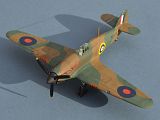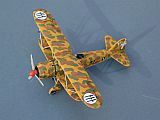April 2023
Hawker Hurricane Mk.1
Fiat CR.42 Falco
Hawker Hurricane Mk.1
418 Flight / 261 Sqn, RAF Hal Far / RAF Takali, Malta, June 1940.
Revell 1/72 with modifications

© www.gengriz.co.uk
Although the Sea Gladiators of the Hal Far Fighter Flight had put up a creditable resistance to Italian raids on Malta, it was clear that the promised Hurricanes were need as soon as possible.
Five Hurricanes were ferried to Malta via France and Tunis at the end of June 1940, joining the Sea Gladiators, but the French surrender on 25 June 1940 stopped deliveries by that route. The first confirmed Hurricane victory was recorded on July 3, when Flg Off J. Waters, flying Hurricane P2614, engaged and shot down a Savoia Marchetti S.79, but later he himself fell victim to fire from a Fiat CR.42 flown by Magg. Ernesto Botto of 9º Gruppo.
Heavy raids against Malta intensified and by the end of the initial month, the Hal Far Fighter Flight was reduced to a single serviceable Hurricane and a pair of flyable Gladiators with 6 pilots.
On 2 August 1940, 12 new Hurricanes embarked on the aircraft carrier HMS ARGUS in the Clyde estuary and set sail for Malta.
The aircraft were to be flown off the deck by RAF pilots who had previously served in the Fleet Air Arm and thus had carrier experience. ARGUS sailed into the Mediterranean under heavy escort. At dawn on 2 August, about 380 miles west of Malta the fighters launched in two waves of six, each led by a Blackburn Skua. The Hurricanes arrived in Malta at the very limit of their range. N2700’s engine cut out over the airfield due to lack of fuel and crashed, fortunately with the pilot surviving. Spares and some ground crew arrived shortly afterwards by submarine.
The newly arrived Hurricanes of 418 Flight were renamed 261 Sqn on 16 August 1940, absorbing the remaining Sea Gladiators of Hal Far Fighter Flight. The Italians soon spotted the new arrivals and mounted a heavy raid on the 5th August that damaged two aircraft, although one Hurricane that was airborne during the raid managed to hit an SM.79 bomber, whilst a single defending Sea Gladiator tangled with the escort of 8 CR.42s.
Hurricanes and the weary Sea Gladiators continued to bear the brunt of fighting over Malta until the arrival of Spitfires in March 1942.
The aircraft depicted by my build this month is N2673, delivered to the island during Operation Hurry. N2673 was lost on 20 May 1941 with Pilot Officer AJ Reeves bailing out injured before the aircraft crashed at Siggiwi, Malta.
Building the Revell Hurricane Kit:
I am a great fan of Revell's 1998-
Unfortunately the Mk.IIC kits seem much more prevalent than the Mk.IIB ones, which is a pity as the older variant is much more interesting to me. Converting to a Mk IIA or "near enough" Mk.IA can be achieved relatively easily by filling the outer gun ports and wing engravings, whilst a Sea Hurricane conversion is even easier (the kits reported failings actually make it better in this respect!).
However, parts fit is only so-
Two types of exhaust stub are provided, with a subtle difference in the size of the exhaust horns. There are also night fighter flame shields (to stop the pilot being blinded by the exhaust) for which you need to drill holes if you want to use them.
The propeller on this kit is quite disappointing, with wide, flashy and poorly defined
blades. I'm not sure if it is intended to be Rotol or DeHavilland -
However, despite the poor fit and some accuracy issues, I do like building these Hurricane kits, so overall, recommended for the more patient modeller, with caveats. But if you can afford it, buy an Arma Hobby kit !
Link to many more RAF WW2 aircraft on my Friends and Allies pages
Part 1









The Hurricanes were guided from the aircraft carrier to Malta by Blackburn Skuas
(left). For later deliveries they were also sometimes met mid-

